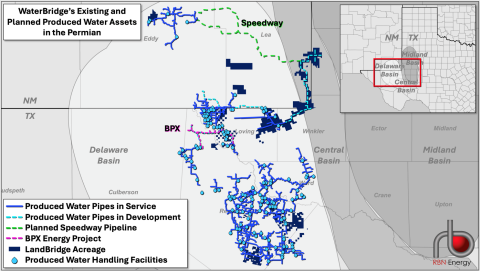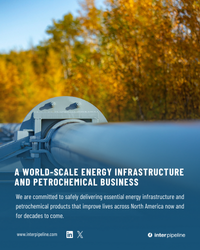Through the early years of the Shale Era, produced water gathering systems in the Permian were mostly small, simple and focused solely on transporting the salty, petroleum- and mineral-tainted water emerging from wells to nearby saltwater disposal wells. In the 2020s, though, these systems — now mostly owned and operated by third-party produced water specialists — have been becoming larger, more interconnected, and more likely to include at least some water recycling and reuse. In today’s RBN blog, we’ll continue our look at big, far-reaching produced water systems in West Texas and southeastern New Mexico.
In Part 1, we summarized what produced water is, how it’s been dealt with over the decades, and what challenges it poses to Permian E&Ps. We also noted that produced water generation in the Permian has been growing quickly — from an estimated 7 MMb/d in 2017 to 21 MMb/d currently — and that produced water volumes are likely to increase by about 1 MMb/d each year to 2030, even if crude oil production stays close to flat. And we pointed out that while the vast majority of the produced water in the Permian’s Delaware and Midland basins is still disposed of in Class II wells (aka saltwater disposal wells, or SWDs), an increasing share — about one-quarter, or 5 MMb/d — is now being recycled for reuse, typically for completing wells but also for enhanced oil recovery (EOR).
We also described the steps that both the Texas Railroad Commission (RRC) and New Mexico’s Oil Conservation Commission (OCC) have been taking to address concerns about seismic activity caused in some specific parts of the Permian by produced water injection. Among other things, they have identified “seismic response areas” (SRAs), set limits on injection rates, and curtailed or suspended injection at certain locations. Lastly, we looked at Western Midstream’s produced water gathering and disposal network in the southern Delaware Basin and the company’s ongoing development of the new 42-mile, 800-Mb/d Pathfinder Pipeline to transport produced water to existing and planned SWDs in eastern Loving County, TX.
Today, we’ll discuss three other large systems in the Permian, each of which helps to show how much the shale play’s produced water sector has grown and evolved over the past few years.
WaterBridge
Houston-based WaterBridge has two primary elements. One is NDB Midstream, a strategic partnership between private equity firm Five Point Energy and investor-owned E&P Devon Energy that owns and operates large-scale produced water gathering, transportation, recycling and disposal assets in the northern Delaware Basin in West Texas and southeastern New Mexico and the Eagle Ford in South Texas. The other is WaterBridge Operating, a portfolio company of Five Point Energy and Singapore sovereign wealth fund GIC that operates sets of similar produced water assets in the southern Delaware in West Texas and the Arkoma Basin in Oklahoma.
In the Permian, WaterBridge has more than 1,700 miles of produced water gathering and transmission pipelines (medium-blue lines in Figure 1 below) and more than 3.8 MMb/d of water-handling capacity at 160-plus facilities (SWDs, recycling plants, etc.; light-blue water drop icons). In January, NDB Midstream and WaterBridge Operating signed long-term agreements with BPX Energy — the U.S. onshore subsidiary of BP — under which the WaterBridge units will build and operate 400 Mb/d of new produced water handling capacity to support BPX’s ongoing development in the Stateline area, with the ability to increase that capacity to 600 Mb/d.
Figure 1. WaterBridge’s Existing and Planned Produced Water Assets in the Permian. Source: RBN
Join Backstage Pass to Read Full Article











